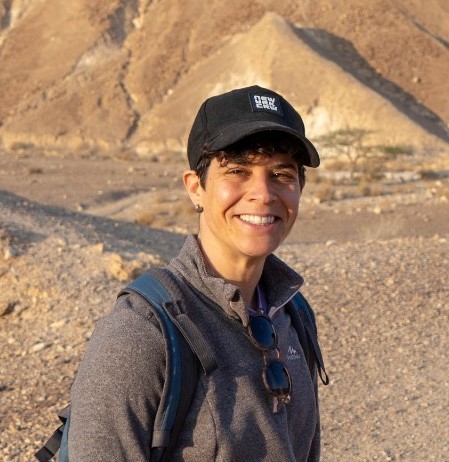Bottom-up Computational Topic Modeling of Facebook Language and Top-down Hypothesis Testing Uncover Boredom Experiences as a Risk Factor for Suicide
PhD Candidate – Technion

Bottom-up Computational Topic Modeling of Facebook Language and Top-down Hypothesis Testing Uncover Boredom Experiences as a Risk Factor for Suicide
PhD Candidate – Technion

Shir Lissak is 31 years old and currently lives in Haifa with Neta, the woman she loves, and Layla, their adopted dog. She grew up in Moshav Kfar-Ahim with one brother and two sisters. Her mother, Shoshi, is a nurse at Kaplan Hospital, and her father, Ruven, is a farmer.
After working as a DS intern at GE Healthcare Group and completing a BSc in Data Science and Engineering at the Technion cum laude, Shir decided to stay in the academy since it allowed her to research and engage in fields that she believes are important and to contribute to the world. With her supervisor, Prof. Reichart Roi, she decided to invest her research in broadening the knowledge about suicidal thoughts and behaviors, a human tragedy that has been growing over the years.
Shir volunteers in “Hoshen” works out daily doing CrossFit, and works on the development of a new course, running for the fourth time concerning Responsible AI (https://teach.responsibly.ai/). She also returns to the moshav to help her family on the farm (especially during the harvest seasons).
Shir Lissak is 31 years old and currently lives in Haifa with Neta, the woman she loves, and Layla, their adopted dog. She grew up in Moshav Kfar-Ahim with one brother and two sisters. Her mother, Shoshi, is a nurse at Kaplan Hospital, and her father, Ruven, is a farmer.
After working as a DS intern at GE Healthcare Group and completing a BSc in Data Science and Engineering at the Technion cum laude, Shir decided to stay in the academy since it allowed her to research and engage in fields that she believes are important and to contribute to the world. With her supervisor, Prof. Reichart Roi, she decided to invest her research in broadening the knowledge about suicidal thoughts and behaviors, a human tragedy that has been growing over the years.
Shir volunteers in “Hoshen” works out daily doing CrossFit, and works on the development of a new course, running for the fourth time concerning Responsible AI (https://teach.responsibly.ai/). She also returns to the moshav to help her family on the farm (especially during the harvest seasons).
Suicide is a tragic human phenomenon in which a person chooses to end their life. In some cases, the suffering of the person can be eased, and the suicide action can be prevented if detected and treated properly. Even though considerable scientific efforts are directed to research suicide ideation, this phenomenon is still hard to detect in its early stages and some of the risk factors are still hidden.In this research, we revealed a new risk factor for suicide by using advanced machine learning (ML) techniques. We developed a pipeline based on natural language processing, a state-of-the-art embedding method, topic modeling, advanced technique, and statistical foundations to uncover new risk factors. We also suggest a closure in which we validate both the potential of the method itself and the outcome of the method as a valid risk factor. The validation process we performed includes traditional psychological tests in contrast to the revealing method, which leans on ML literature and techniques.
Suicide is a tragic human phenomenon in which a person chooses to end their life. In some cases, the suffering of the person can be eased, and the suicide action can be prevented if detected and treated properly. Even though considerable scientific efforts are directed to research suicide ideation, this phenomenon is still hard to detect in its early stages and some of the risk factors are still hidden.In this research, we revealed a new risk factor for suicide by using advanced machine learning (ML) techniques. We developed a pipeline based on natural language processing, a state-of-the-art embedding method, topic modeling, advanced technique, and statistical foundations to uncover new risk factors. We also suggest a closure in which we validate both the potential of the method itself and the outcome of the method as a valid risk factor. The validation process we performed includes traditional psychological tests in contrast to the revealing method, which leans on ML literature and techniques.
| 8:45 | Reception |
|---|---|
| 9:30 | Opening words by WiDS TLV ambassador Nitzan Gado and by Lily Ben Ami, CEO of the Michal Sela Forum |
| 9:50 | Prof. Bracha Shapira – Data Challenges in Recommender Systems Research: Insights from Bundle Recommendation |
| 10:20 | Juan Liu – Accounting Automation: Making Accounting Easier So That People Can Forget About It |
| 10:50 | Break |
| 11:00 | Lightning talks |
| 12:20 | Lunch & poster session |
|---|---|
| 13:20 | Roundtable session & poster session |
| 14:05 | Roundtable closure |
| 14:20 | Break |
| 14:30 | Merav Mofaz – “Every Breath You Take and Every Move You Make…I'll Be Watching You:” The Sensitive Side of Smartwatches |
| 14:50 | Reut Yaniv – Ad Serving in the Online Geo Space Along Routes |
| 15:10 | Rachel Wities - It’s Not Just the Doctor’s Handwriting: Challenges and Opportunities in Healthcare NLP |
| 15:30 | Closing remarks |
| 15:40 | End |
WiDS Tel Aviv is an independent event that is organized by Intuit’s WiDS TLV ambassadors as part of the annual WiDS Worldwide conference, the WiDS Datathon, and an estimated 200 WiDS Regional Events worldwide. Everyone is invited to attend all WiDS conference and WiDS Datathon Workshop events which feature outstanding women doing outstanding work.
© 2018-2023 WiDS TLV – Intuit. All rights reserved.
Scotty – By Nir Azoulay
Design: Sharon Geva